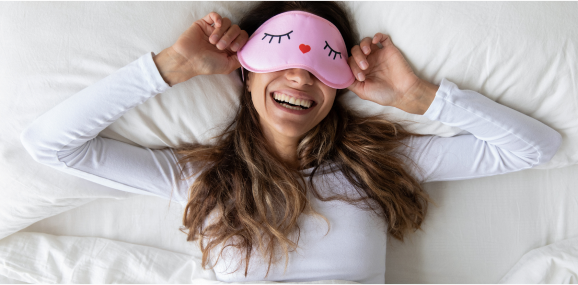First you had issues sleeping. You jumped on the internet, did a little digging, learned about deep touch pressure therapy, and decided to buy a weighted blanket. For a few nights, you felt better, but you started waking up feeling sore.
Could it be the blanket? Maybe.
Weighted blankets have been around since the late 1990’s. These blankets offer a way for your body to relax and help support sleep. Many users liken them to a warm hug. However, if you want to use a weighted blanket, you should know how to use them properly, and know about any risks involved with them.
Your team at Hug Sleep loves the benefits of deep touch pressure stimulation, and we understand how weighted blankets should work. If you’re waking up sore, we can help you understand why.
How Do Weighted Blankets Work?
It all started with a growing problem that was affecting a huge portion of the population. People were stressed. Feeling overwhelmed, anxious, and worried people were losing sleep. It’s estimated that currently, at least 1 in 4 Americans suffer from sleep disorders.
While taking sleep aids may be a quick fix, using them is like putting a bandage on a festering wound. The problem is deeper, and tackling the underlying causes of our sleeplessness is the best way to get better rest.
Soothing Stress
Research into behavioral therapy revealed that, much like the comfort of a warm hug, pressure applied to the body during times of high stress could have the same soothing effect.
In fact, research showed that this method, called deep touch pressure therapy (DTPT), could trigger the release of hormones like serotonin and dopamine, both of which keep the body relaxed and calm.
Weighted blankets use deep touch pressure therapy to help relax the user, calm them, and support sleep. Using a weighted blanket before bed can promote restfulness.
DTPT and Your Nervous System
Your nervous system is complex, but for our purposes we’ll talk about its two main modes of operation, the sympathetic nervous system (SNS) and the parasympathetic nervous system (PSNS).
Your SNS is the portion of your nervous system that heightens your awareness, stimulates the release of cortisol, quickens your heartbeat, and puts you on full alert. When you’re operating in SNS, you can feel stressed, worried, or nervous.
The SNS is important, and it helps us muscle through workouts, complete tasks on time, and make snap decisions at crucial moments. However, it’s not good at allowing us to sleep.
Your PSNS is like the yin to the SNS yang. Your PSNS relaxes your muscles, triggers the release of serotonin and dopamine, slows your heart rate, and improves digestion. Your PSNS promotes a state of relaxation, the kind you need when you want to go to sleep.
Deep touch pressure therapy helps your body transition between the SNS and the PSNS. Think of it like switching from high power to medium power on a power tool.
How Are Weighted Blankets Made?
Most weighted blankets are made with a quilted design that allows the filling to be placed in individual pockets. These pockets allow for even distribution of weight. The filling can be similar to what you’d find in a modern-day bean bag; pellets, small ball bearings, natural grains, and even sand.
The exterior of a weighted blanket is made from different materials so that the user can pick something that is most comfortable for them.
Are Weighted Blankets Safe?
Generally speaking, yes, weighted blankets are safe when used correctly. That said, here are four safety precautions you should adhere to when using a weighted blanket.
1. Use the Right Weight
A five pound weighted blanket won’t feel very heavy on a 200 pound body, but it would feel close to oppressive on a small child. The rule of thumb is to use a weighted blanket that is about 10% of your body weight.
Thus, if you weigh 140 pounds, you’ll want a weighted blanket that weighs no more than 14 pounds.
2. The User Should Be Physically Capable of Removing the Blanket
It goes without saying, a weighted blanket isn’t for a baby. They lack the physical ability to remove the blanket from their bodies. Likewise, if you have trouble lifting the blanket from your body or have a limitation that prevents you from removing it, you shouldn’t use a weighted blanket. You need to be able to remove the blanket from on top of yourself, or it’s not safe to use.
3. Certain Conditions Don’t Mix With Weighted Blankets
If you have certain medical conditions like sleep apnea or COPD, you should avoid using a weighted blanket as they could make your symptoms worsen.
4. Don’t Use a Weighted Blanket on Small Children
Using a weighted blanket on small children is not ever recommended for children under the age of 2. If you think your child will benefit from the use of a weighted blanket, talk to their healthcare professional to make sure they do not have any physical limitations that could make it unsafe.
Is My Weighted Blanket Making Me Sore?
If you’ve followed all the rules and are waking up sore and achy, you’re likely frustrated. If weighted blankets are so beneficial, why aren’t they working for you? Research has even pointed to weighted blankets as being useful for people who suffer from chronic pain.
Your weighted blanket could be making you sore, but let’s look at all the possibilities.
The Blanket Is Too Heavy
It’s easy to get a weighted blanket within the current weight range and feel like it isn’t heavy enough. Trust that it is, and dial back the weight of your blanket. If your blanket is too heavy it could be forcing you to engage muscles while you sleep to help support your body under the weight of the blanket. That alone could cause you to wake up feeling stiff.
The Blanket Is Damaged
If your blanket is damaged the filling could be collecting in one particular area, placing an undue amount of pressure on that area of your body. This could result in you feeling sore in one spot, and even cause enough pressure to interfere with your circulation, resulting in tingly toes when you crawl out of bed.
Weighted Blankets Just Aren’t Comfortable For You
Sometimes a great solution isn’t the solution for you. If you consistently wake up feeling achy and sore, it could be that you simply aren’t comfortable under your weighted blanket. Being uncomfortable can place you in a position at night that makes it hard for you to relax and get to sleep. The result? Waking up tired, cranky, and stiff.
If you want the benefits of DTPT without the use of a weighted blanket, you’ve got options.
Weighted Blanket Alternatives
You don’t have to use a weighted blanket to get the soothing benefits of deep touch pressure stimulation. There are alternatives that may work better for you and allow you to wake up feeling rejuvenated instead of sore.
Compression Clothing
Clothing that is tight fighting and applies compression can give your body deep touch pressure stimulation, although it’s probably not the best solution for bedtime. This clothing can feel constricting, and can even cause you to sweat and chaffe: two ingredients for a bad night’s sleep.
DIY Methods
A simple internet search will reveal numerous DIY methods of making your own weighted blanket experiences. One we saw even including using dumbbells. Suffice it to say, these are all around bad ideas that could be seriously dangerous. Placing objects on top of your regular blankets isn’t an effective way to use DTPT either, because the pressure is almost never evenly distributed.
Wearable Blankets
Wearable blankets pick up where weighted blankets left off, solving some of the major issues users didn’t like about them. Wearable blankets are lighter, apply more even, consistent pressure without adding weight, and are generally more comfortable for the user.
The Sleep Pod
The Hug Sleep Sleep Pod is based on the science of DTPT and the innovative ideas of our founders. They wanted a weighted blanket alternative that was comfortable, easy to use, allowed for maximum mobility, and was comfortable underneath bedding.
The Hug Sleep Sleep Pod was born from these ideas.
Our Sleep Pod provides a cocoon of comfort that will never leave you waking up stiff and sore. Instead of weighted pellets, the Sleep Pod uses four way stretch fabric to apply equal pressure to your body as you rest.
Our Sleep Pod Move ensures you have the freedom to move and change positions throughout the night with ease. A specialized pouch at the bottom of the pod allows you the freedom to remove your feet from the Sleep Pod when desired.
Breathable fabric and optional sizes ensure you’re getting the perfect amount of DTPT stimulation to help relax your body and support a healthy night of sleep.
Say Goodbye to Morning Soreness
Weighted blankets help ease your body into rest by using deep touch pressure therapy, however, some users might find they wake up feeling sore after using them. A better solution is a wearable blanket that applies even pressure without added weight.
The Hug Sleep Sleep Pod gives you the ability to use deep touch pressure stimulation without the burden of a blanket. Support your comfort and your sleep, and check out the Sleep Pod here.
Sources:
The effects of deep pressure touch on anxiety|PubMed.NCBI.gov
https://www.sciencedirect.com/science/article/abs/pii/S1526590021003138?dgcid=rss_sd_all

































500,000+ happy customers